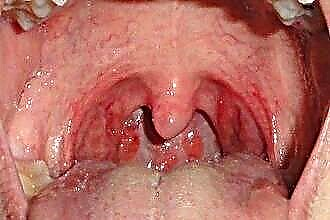The effectiveness of the treatment of a malignant tumor depends on its location, histological form, as well as the stage of the disease. Clarification of the diagnosis in the early stages is a prerequisite for the timely initiation of treatment and optimistic forecasts. Especially difficult is the early diagnosis of throat cancer, when the clinical symptoms of the tumor are masked by other inflammatory processes. The methods of early diagnosis include the determination of the appropriate tumor marker in the blood. Since markers can characterize various pathological processes occurring in the body, it is important to clarify which tumor marker shows throat cancer and to conduct a study.
Analysis and interpretation
 Tumor markers are chemicals that the body synthesizes. Some of them are formed in the body constantly, others - only with cell mutation, that is, with the development of a malignant tumor. It is these substances that are of interest for oncology. Determination of these chemical compounds in blood is a promising method for early diagnosis of a tumor process.
Tumor markers are chemicals that the body synthesizes. Some of them are formed in the body constantly, others - only with cell mutation, that is, with the development of a malignant tumor. It is these substances that are of interest for oncology. Determination of these chemical compounds in blood is a promising method for early diagnosis of a tumor process.
After the development of tumor markers by the cancer cell, some of them enter the bloodstream, which allows them to be detected there. Such tumor markers can differ from substances produced by healthy cells, quantitatively or qualitatively. This is what the diagnostic technique is based on.
All currently known tumor markers are not specific to any particular organ. This is the flaw in research. Determination of a tumor marker is not a reliable specification of a tumor of a particular localization.
The interpretation of the analysis should be carried out in conjunction with the results of other studies, the clinical picture, and other factors.
In throat cancer, the most informative tumor markers are SCC, CYFRA 21-1, where SCC is an antigen of squamous cell carcinoma, the most common form of malignant lesions of the larynx, CYFRA 21-1 is a marker of any oncological process. Normally, the SCC level in the blood is up to 1.5 ng / ml. If the blood test shows an increase in this indicator, this indicates the presence of squamous cell carcinoma in the body of any localization. The larynx or other organ lined with squamous epithelium may be affected.
Only taking into account the existing assumptions based on the results of other studies, patient complaints, it is possible to interpret this analysis and clarify the localization of the process. In addition, in severe diseases occurring in the body, an increase in the level of a tumor marker may also be noted. A slight excess of the upper limit of the indicator is typical for such somatic diseases as
- tuberculosis;
- eczema of the skin;
- pathology of the liver and kidneys.
A test result in the range of 2ng / L is very typical for throat cancer. An increase in the values in dynamics up to 3 ng / l indicates the ineffectiveness of the therapeutic measures and the ongoing development of the tumor process. The same results can be interpreted as insufficiently radical surgical intervention, indicating that the tumor was not completely removed. The most informative SCC study is to clarify the presence of a relapse of the disease and monitor the effectiveness of the therapy.
CYFRA 21-1 is investigated similarly. Normally, the indicators of this tumor marker should not exceed 2.3 ng / l. With the development of throat cancer, this figure reaches 3.5 ng / l. If metastases develop to distant organs, it exceeds 5ng / l. This analysis can show the effectiveness of chemotherapy, radiation exposure, or surgery.
Methodology
There are certain requirements for a blood test for the quantitative content of tumor markers. The study is highly sensitive. Fluctuations above the norm can be observed in patients with alcoholism who have been a smoker for a long time. To reduce the possible error, it is necessary to comply with certain diagnostic requirements:
- the patient on the eve of the study should not consume alcoholic beverages and smoke;
- the analysis is taken on an empty stomach in the morning;
- the interpretation of the results should be carried out by the attending physician of the patient.
It is necessary to take into account that the limits of the norm of the determined tumor marker may differ in different methods.
Each laboratory must indicate the acceptable numerical limits on the result sheets.
 The definition of a tumor marker is not a publicly available study. Laboratories at district polyclinics do not have the appropriate facilities for its research. In addition, the cost of this analysis is not yet affordable for all categories of the population. Considering that the shown result is not a diagnosis, and the patient's condition needs further research, tumor markers cannot be used as preventive studies. Their goal is to monitor the result of treatment, to determine the presence of a relapse of the disease.
The definition of a tumor marker is not a publicly available study. Laboratories at district polyclinics do not have the appropriate facilities for its research. In addition, the cost of this analysis is not yet affordable for all categories of the population. Considering that the shown result is not a diagnosis, and the patient's condition needs further research, tumor markers cannot be used as preventive studies. Their goal is to monitor the result of treatment, to determine the presence of a relapse of the disease.
Preventive research
There are other tests that make it possible, in a more accessible form, to suspect the presence of oncopathology in a patient. These include a general blood test, which is included in the list of mandatory studies for any routine examination of a patient, medical examinations, hospitalization.
The development of a malignant process in the body is evidenced by an increase in ESR, leukocytosis and the development of anemia. All these signs can characterize other processes in the body. They can be inflammatory in nature, or be caused by the effect of a specific pathogen. If such results are found, the patient, based on complaints and anamnesis, should be sent for examination to an appropriate specialist to clarify the diagnosis and exclude a malignant process.



